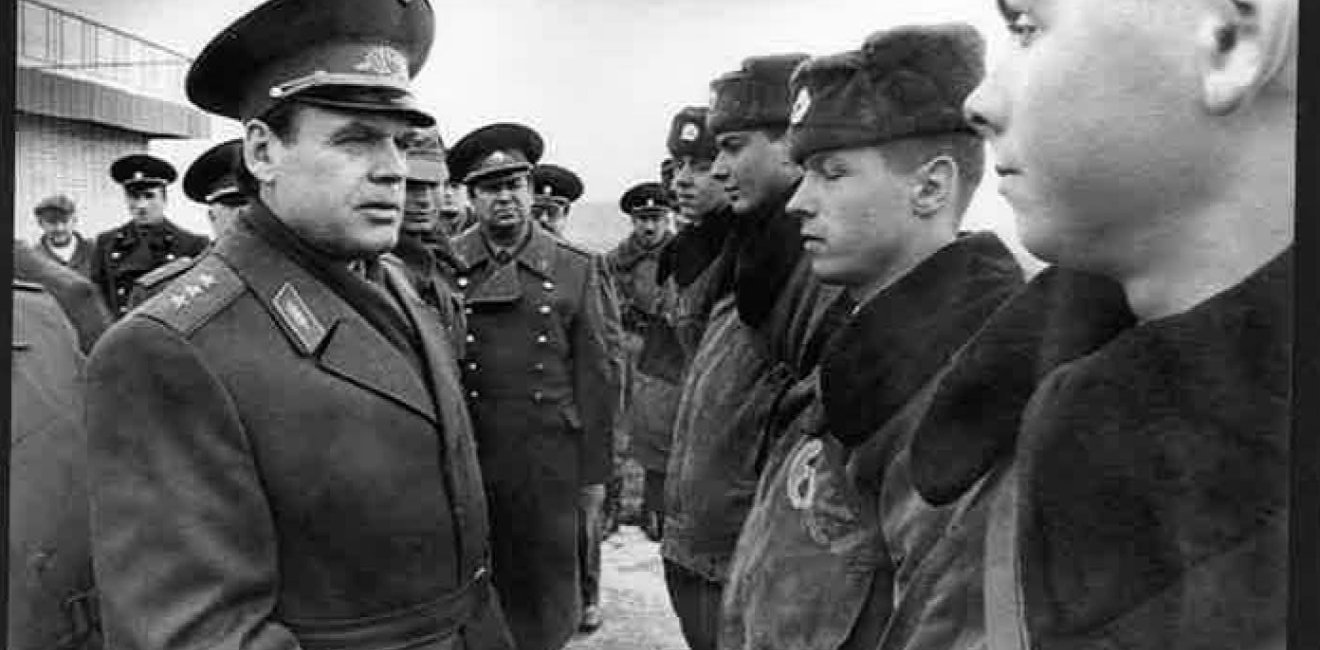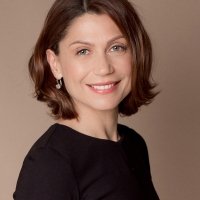Against All Odds
Mariana Budjeryn describes how Kostiantyn Morozov brought about the unlikely establishment an independent Ukrainian military.

A blog of the History and Public Policy Program
Mariana Budjeryn describes how Kostiantyn Morozov brought about the unlikely establishment an independent Ukrainian military.

Above: General Morozov inspecting troops of a tank unit at the Yavoriv Training Range in Western Ukraine, 1992
Kostiantyn Morozov and the Unlikely Establishment of Ukraine’s Military
Researchers like to share archive war stories: traveling across the world to review foreign archives, cutting through red tape to obtain access, deciphering incomprehensible finding aids, and, if luck is on their side, finding a pearl of a document.
Sometimes, however, archival pearls lurk in much quieter waters. I spent weeks in Almaty, Minsk, and Kyiv collecting sources on the nuclear disarmament of Ukraine, Belarus, and Kazakhstan after the collapse of the Soviet Union. Yet one of the most surprising finds turned up close to home in Cambridge, Massachusetts.
Browsing through the Harvard library catalogue, I stumbled upon a collection of oral history interviews with Ukraine’s first defense minister—Colonel-General Kostiantyn Morozov. General Morozov belongs to the generation of Soviet military leaders whose lot it was to preside over the disintegration of the Soviet Union and its gargantuan army. Yet his story is not about the demise of the old Soviet system but about the precarious birth of a new state—Ukraine—and its armed forces.
Born in Donbas to a Russian father and a Ukrainian mother, Morozov graduated from Kharkiv Higher Military Aviation School in 1967 and went on to have a successful career in the Soviet Air Force. In 1988, after twenty-one years of service outside of Ukraine, he was appointed the commander of the 17th Air Army headquartered in Kyiv. After the failed coup in Moscow in 1991, General Morozov suddenly found himself spearheading the monumental task of establishing Ukraine’s defense agency and forging Ukraine’s independent armed forces out of some 750,000 Soviet troops deployed in Ukraine. He was the first serviceman to take Ukrainian military oath on December 6, 1991 in the Rada session hall.
The Morozov collection, which can be requested through the Harvard Ukrainian Research Institute (HURI), consists of hours of taped and transcribed interviews given by Morozov in 1996 during his time as a fellow at Harvard’s Belfer Center, as well as copies of government documents and photographs from Morozov's personal archive. While some of the material was translated and compiled into Morozov’s English-language memoir Above and Beyond, the Ukrainian-language transcripts hold much more. The most consistent and comprehensive set of interviews were conducted by Canadian political scientist and historian John Jaworsky.
Morozov’s account reminds us that independent Ukrainian armed forces, like the independent Ukrainian state, emerged in the face of greatly unfavorable odds. After the first multiparty elections in March 1990, the Communist Party retained an overwhelming majority in the Verkhovna Rada (Ukraine’s parliament). Only about a quarter of the Rada seats went to the national-democratic opposition, comprising mostly literati and former political dissidents, whose agenda included full independence from Moscow.
Joining the parade of sovereignties, the new Rada passed, on 16 July 1990, the Declaration of Sovereignty of Ukraine paving the way to independence. Against a bitter opposition of Communist MPs, the pro-independence faction managed to include in the declaration’s Article 9 a provision for the creation of an independent Ukrainian armed forces.
If the idea of Ukraine having its own military was controversial in the Rada, it was an absolute taboo among military brass. According to Morozov, the top military commanders in Ukraine “were absolutely certain that Ukrainian independence was absurd and that a Ukrainian army was a state and military crime.”[1] The text of the declaration was never circulated within the military.[2]
Change, however, was in the air. The sessions of the new multiparty Rada, aired on TV and radio, turned into genuine forums for impassioned debates about national identity, history, past Soviet atrocities, the ills plaguing the dysfunctional Soviet system, and the need for democratization. That these matters should be discussed openly in a public forum was simply inconceivable just a few years prior.
Morozov himself went through a profound change from a Soviet general to a Ukrainian statesman in 1990-1991. Although Morozov was born in Ukraine and was half-Ukrainian, he did not strongly identify as a Ukrainian in ethnic terms. A Russian-speaker, he spent most of his adult life outside Ukraine and was deeply socialized into the Russo-centric culture of the Soviet military. His sympathy toward the cause of Ukrainian independence evolved gradually as he followed the Rada deliberations and listened to the arguments of the national-democrats.
Morozov recalled being influenced by the eloquence of poet Ivan Drach and the dignified authority of Levko Luk’yanenko, a dissident and 27-year veteran of Soviet labor camps. But above all, he found the national-democrats’ position just: “Anyone capable of perception, judgement, and drawing one’s own conclusions could not help but empathize… The justice of [their] statements about the fate of the Ukrainian people, Ukrainian culture… was irrefutable.”[3]
On August 27, a few days after the anti-Gorbachev coup in Moscow was foiled and Ukraine proclaimed full independence from Moscow, the Speaker of the Rada and future president of Ukraine, Leonid Kravchuk, called a meeting of the top military command serving in Ukraine: the chiefs the three military districts, Kyiv, Odessa, and Carpathian, commanders of all armies, and of the Black Sea Fleet. Kravchuk presented the resolution of the Rada, subordinating all military formations on Ukrainian territory to the Rada and ordering the creation of Ukraine’s ministry of defense.
The resolution was met with a stone-faced rejection by the overwhelming majority of the military cadre present, who were hostile to the idea in principle, but also argued that it would be simply impossible to untangle and parcel out the highly-centralized Soviet military. Morozov was the only commander to voice cautious support for the resolution, a position that would have put him at great personal and professional risk had the Soviet state endured. A week later he was offered the job of Ukraine’s minister of defense. Until January 1992, he remained the only person on the ministry’s staff, although he relied on the support of a handful of high-ranking officers who later became the core of Ukraine’s fledgling defense establishment.
Much of Morozov’s recollections concern the uphill battle of establishing a legal and institutional underpinning for Ukraine’s own military and defense agency against the stalwart Russian resistance: concerns about the loyalty of the officer corps and the debate over the ownership of former Soviet military assets—most notably the Black Sea Fleet and Strategic Rocket Forces.
Above: General Morozov and President Kravchuk reviewing the new Ukrainian military uniform insignia, September 1993, one month before Morozov resigned as a Minister of Defense. Photo by Pavlo Poschenko.
Throughout the fall of 1991 and winter 1992, political and institutional pull to preserve the status quo of a giant centralized military system under Moscow’s command was formidable. Much of the Soviet military brass, marginalized and embittered by Gorbachev’s reforms of the late 1980s, saw the fragmentation of Soviet military might as a continuation of the humiliating strategic retreat from Eastern Europe. The Soviet Union’s last minister of defense, Airforce Marshal and Morozov’s one-time direct superior Yevgeniy Shaposhnikov made no secret that his foremost task was to prevent the disintegration of the Soviet military.
Efforts to preserve a single military-strategic space did not cease with the official disintegration of the Soviet Union in December 1991. The standing Soviet army of some 3.7 million and all its assets became rebranded as “Joint Armed Forces” of the newly-formed Commonwealth of Independent States (CIS), with Shaposhnikov as Commander-in-Chief. Ukraine’s persistence in creating an independent military and the refusal to participate in Joint Armed Forces was perhaps the most significant factor in foiling the efforts to preserve the Russian-controlled military arrangement under the CIS umbrella—an effort to which many political and military leaders in Russia, Belarus, and Kazakhstan were deeply committed. At the core of Ukraine’s push were just a handful of persistent and committed people, most notably Morozov.
Historical counterfactuals are tricky, yet it is tempting to consider what course events would have taken had General Morozov never been appointed to a senior military position and stationed in Kyiv in 1988. What if he arrived later, with no time to be persuaded by what, at the time, amounted to heretical views on Ukrainian statehood? What if Morozov did not speak up at the August 27 meeting? Had the command of the military units in Ukraine remained solely in Moscow’s hands, would strategic nuclear forces have been withdrawn from Ukraine’s territory?
Morozov’s interviews are a treasure trove for any researcher interested in Soviet military culture, ethnic relations within the Soviet military, party-military relations, or the establishment of Ukraine’s independent armed forces throughout 1992–1993. They also contain some unexpected gems, such as the recollection of Morozov’s encounters with Dzhokhar Dudaev, an ethnic Chechen long range bomber pilot and squadron commander who served under Morozov in Poltava, Ukraine, and went on to become Chechenia’s only general and later, a leader of the Chechen independence movement.
Above all, Morozov’s story reminds us that there is nothing inevitable about present outcomes. History is shaped as much by a whirlwind of grand social transformations as by the will of individuals acting out their conceptions of the past and visions for the future. It is in this very real sense that General Morozov made history.
[1] Kostiantyn Morozov Collection (1991-1996), Harvard Ukrainian Research Institute, Interview by John Jaworsky, January 17, 1996, Transcript of Tape 2, p. 8. Location in Hollis Catalogue: http://hollis.harvard.edu/primo_library/libweb/action/dlDisplay.do?vid=HVD&search_scope=default_scope&docId=HVD_ALEPH011486936&fn=permalink. All translations from Ukrainian by the author.
[2] Ibid., p. 18, 20.
[3] Ibid., p. 12.


A leader in making key foreign policy records accessible and fostering informed scholarship, analysis, and discussion on international affairs, past and present. Read more


The Cold War International History Project supports the full and prompt release of historical materials by governments on all sides of the Cold War. Read more


The Nuclear Proliferation International History Project is a global network of individuals and institutions engaged in the study of international nuclear history through archival documents, oral history interviews, and other empirical sources. Read more



